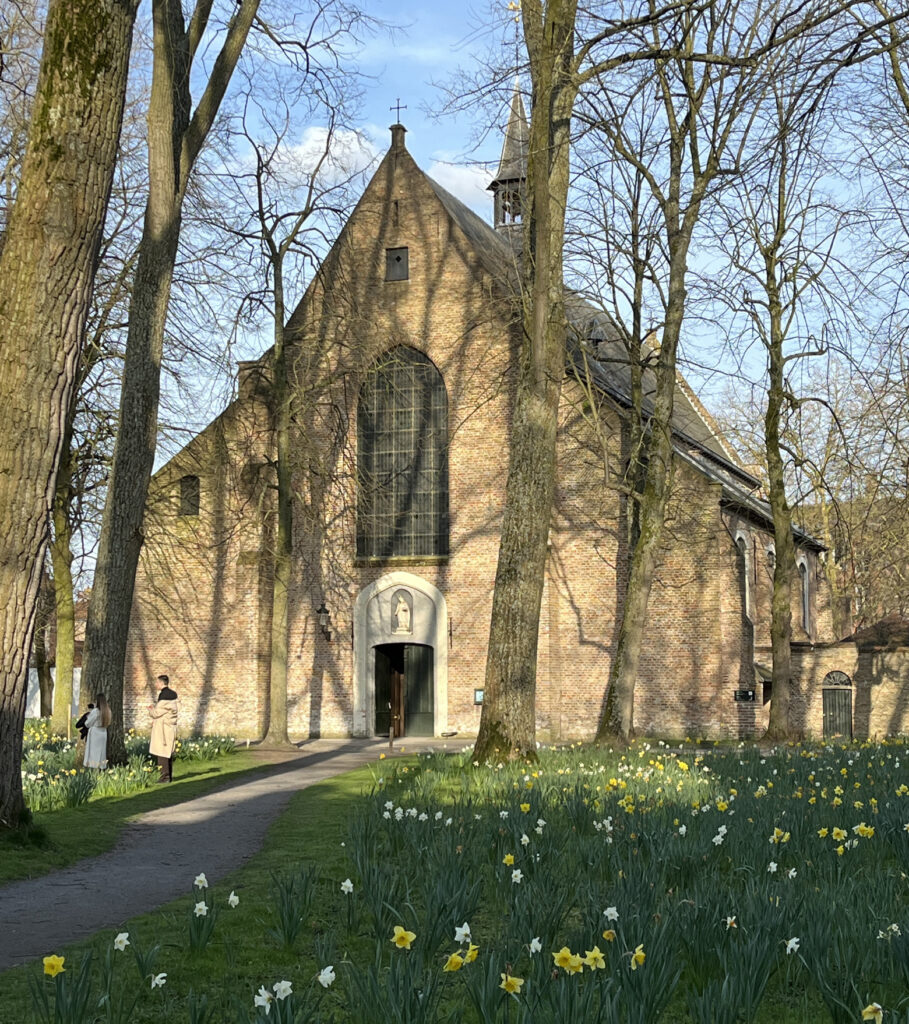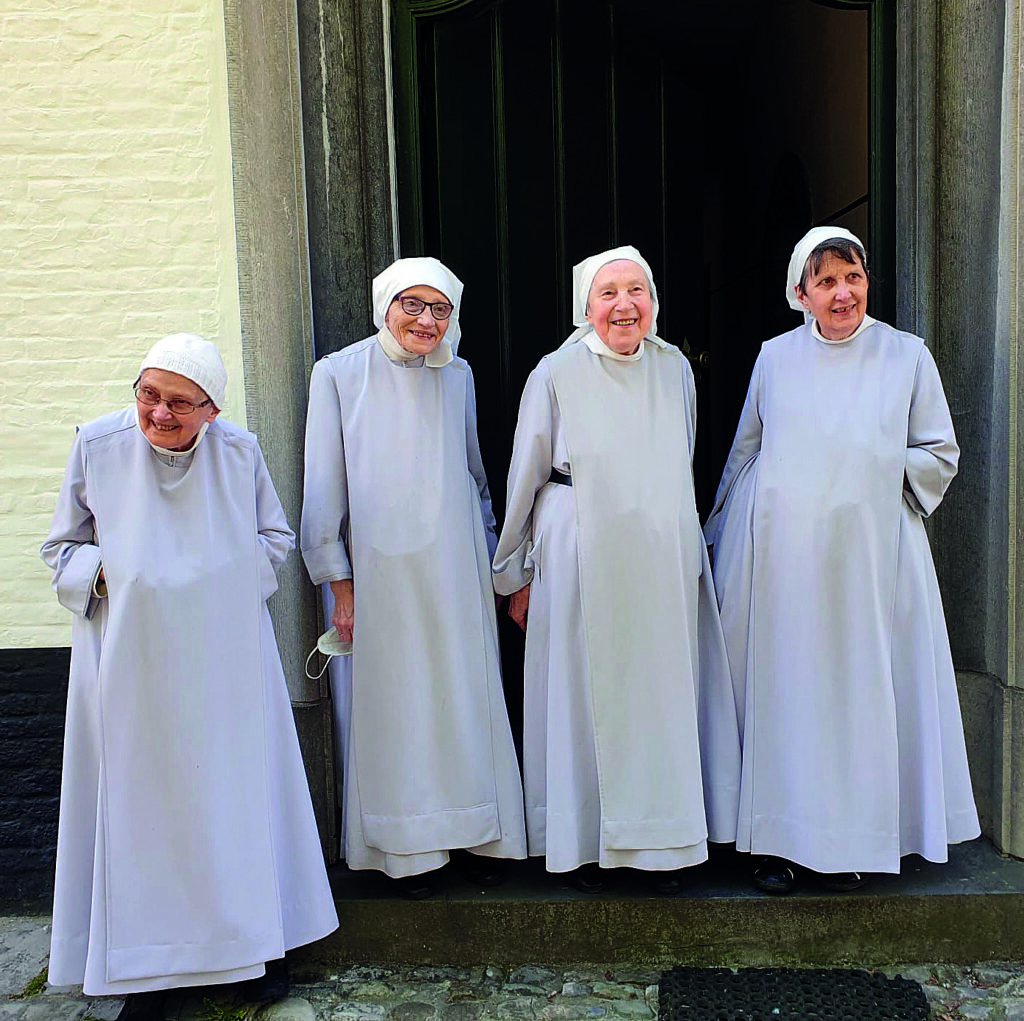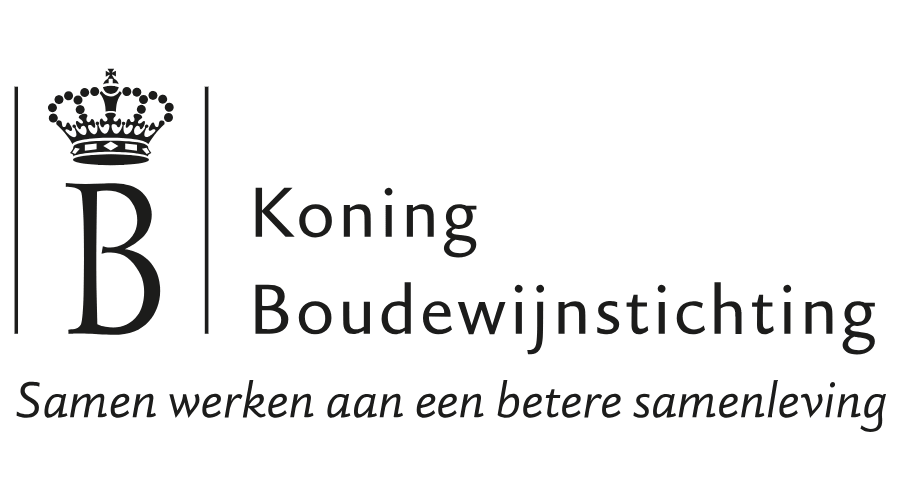The 12th century is one of religious rebirthSeveral new, also dissident, religious ideas and movements emerged possibly as a critical note against the clergy of the time. After all, clergymen did not always behave in a pious way and were very much aiming to live in wealth.
From the end of the 12th century onwards, some single women or widows sought a safe place to live close to a city. These pious women were looking for a simple life of prayer and work, the mulieres religiosae or beguines. The first beguines sometimes went far in their spiritual life and mystical ideas that were influenced by the great Christian thinkers. An important source of inspiration at that time is Marie of Oignies (1177-1213), a well-known mystic and perhaps a 'beguine'. The word 'beguine' appears for the first time around 1220 in a text by a Cistercian monk.
Beguines are not monastics nor nuns, they do not lose their economic independence at all, and can go back to their old secular life at any time. They are mainly active in the linen and handicraft industry, but also in the caretaking of the sick and orphans. Their revenues and the personal belongings they brought with them, make beguines financially independent. Over the centuries, they built up a considerable patrimony.
The beguinage is a highly structured community headed by a Grand mistress. She is assisted by six sub-mistresses and four councelors. A number of beguines are also given specific tasks with colourful Flemisch names.
The beguines actively practice their faith in their closed community of women. They are looking for a balance between a spiritual and active life. In addition to their economic activities, a strict rule of life determines their daily schedule of the spiritual moments. In the evening, after suns, the gates of the beguinage close up and a general silence sets in until the next morning
From the 15th century onwards, the emphasis in the Bruges beguinage shifts more and more to the strict practice of religious duties and choral singing, to the detriment of their active duties. As early as the 13th century, the beguines already have established a schola cantorum, whose young female students grace the religious services with choral singing. This schola cantorum is also a training school for new beguines. Their songs are collected in graduals, some of which have been preserved.
The beguines, their way of life and their own jurisdiction are regarded with suspicion by the community and local authorities because they emphasize their independence. Both secular and religious authorities try to impose growing control over their whereabouts and practices. Nevertheless, we can speak of an emancipatory women’s movement.

A secluded and safe place
The Bruges beguinage is erected outside the first walls of the city. For safety reasons it is almost completely walled or bordered by canals. Originally the size was larger than it is today (about 6 hectares) and extends between the neighbouring streets. Part of the adjacent place (Wijngaardplein) and its surroundings belong to the property. At the end of the 13th century, the bleaching meadows of the beguinage ran up to the second city walls.
Unity of style
Beguines possess their own private houses or live together in convents and infirmaries. This organization strongly determines what we see today: an open central courtyard dominated by the church and surrounded by spacious, white-painted houses from the late 16th, 17th and 18th centuries. Some even have older construction elements. All of them have private gardens.
The beguinage church, of which the oldest traces date back to 1245, is restored after the fire of 1584.
The interior upholstery dates mainly from the 17th and 18th centuries.
The main gate from 1776 is reached by the Wijngaardbrug. In the niche above the gateway thrones a statue of Saint Elisabeth of Hungary, patroness of the Bruges beguinage. When the nearby Minnewater Hospital is founded around 1890 on parts of the grounds of the beguinage, architect Louis Delacenserie builds new walls and realizes a second entrance gate near the lock house on the Minnewater (Love lake). In 1937, the house of the Grand Mistress and several adjacent houses were converted into a Benedictine monastery.
A unique urban settlement
Beguinages are important urban settlements in the city fabric. Generally, they form an architecturally homogeneous ensemble with houses, church, infirmary and sometimes also a bakery, farm and brewery. The Beguinage is cut off from the 'outside world' by walls and canals. Generally the residential buildings are arranged along a large green square or along streets.

Unlike monastery gardens, the courtyard of the beguinage is open to the public during day-time. The beguinage gates close between sunset and sunrise. The monastic community and the houses all have private gardens. The monastery garden consists of several garden types: an ornamental garden, a vegetable garden, an orchard and a secluded cloister garden.
The historic buildings and church, a variety of open spaces and gardens, the beguinage walls, valuable plants and trees all together form a unique landscape with great heritage value. From the 17th century on the central courtyard is planted with trees such as Canadian Poplar (Populus x canadensis), Common Ash (Fraxinus) and Lime trees (Tilia). Daffodils, wild orchids and many other wild flowers bloom in spring. An old cobblestone pavement frames the central green square.
In terms of biodiversity, the courtyard is exceptionally valuable due to the presence of these wild orchids (Spotted Orchid, Mountain Night Orchid, Large Beetle Orchid, Broad Wasp Orchid). A number of plant species are on the Flemish List of plants threatened with extinction. Some species are even protected by law.
Finally, the canals are of historical heritage value because they are prominent in the beguinage. They played a role as a natural boundary, but also as a cattle watering place and linen washing area. The adjacent garden grounds were mainly used as bleaching meadows.

In 1789, after the French Revolution, the possessions of beguinage De Wijngaard were confiscated and transferred to the Commission for Civil Alms-houses (the current Social Security Services). The beguines were allowed to stay in their houses, but the beguinage could not accept new beguines. In1803 they were allowed to use the church again and in 1804 they were authorized to wear their habit again.
However, it turns out to be impossible to restore the former glory of De Wijngaard. In 1881, the Commission for Civil Alms-houses decides to establish a new hospital, the Minnewater Hospital, on an important piece of bleaching meadow of the beguinage. City architect Louis Delancenserie (1838-1909) designs the building in a characteristic Neo-Gothic style. A newly constructed street divides the hospital from the beguinage.
Pastor Hoornaert
In 1922, only five Beguines still lived in a dilapidated beguinage.
At that time, Rodolphe Hoornaert (1886-1969) is appointed parish priest and religious governor. He wants to save the
seven-hundred-year-old beguinage of further deterioration. Moreover, he wants the life of the beguines to revive.
In August 1925 R. Hoornaert sets up a three-day festival to celebrate the 700th anniversary of the foundation of the beguinage. He wants to attract as many sponsors and as much money to be able to restore the beguinage.
However, Hoornaert does not succeed in reviving the beguine movement. With the support of the last Grand Misstress and a local Benedictine abbey, he founds a new congregation. In 1927 Les filles de Saint-Benoît from Nîmes (France) merge with the remaining beguines and, as a new congregation, adopt the Saint-Benedict's Rules of Life. Beguine and Grand Mistress Geneviève de Limon Triest (1874-1971) becomes the first prioress of the new community named Daughters of the Church. To preserve the tradition of the beguines, the nuns wear their traditional habit. Despite some growing pains, the new congregation has many vocations in France, Ireland, Scotland and later Switzerland, Hungary, Norway and the Netherlands. The international character of monastery De Wijngaard is eminent. The conversion of the house of the Grand Mistress and some beguine houses result in new monastery buildings. The building campaign takes place between 1926-1937, in a local architecture that is similar to the rest of the Beguinage.
100 years
Today, after almost hundred years, the number of nuns in the monastery is again declining and the religious presence in the beguinage is once again problematic. Some thirty remaining beguine houses are rented out to single women.
Despite a very high number of visitors strolling through the beguinage grounds silence and tranquillity remain prominent characteristics for the sense of the place.
The beguinage has been owned by the City of Bruges since 1972. Since this date on, the City has been responsible for the preservation and management of the built heritage and has launched successive restoration campaigns. Originally the Benedictine nuns received a long lease and were responsible for the day-to-day management and rental of the houses. That ground lease ran until 2035, but in 2020 was transferred to the City of Bruges, which is now responsible for all aspects of management of the site.

7-times protected
Since 1939, the Princely Beguinage De Wijngaard has been protected seven times by local heritage laws as listed landscape, monument and townscape. The beguinage is twice listed as a UNESCO World Heritage Site. (Flemish Beguinages, December 2nd 1998 – Historic City Center of Bruges, November 30th 2000
WHAT MAKES THE BRUGES BEGUINAGE SO UNIQUE?
The beguinage of Bruges is a well-preserved enclosed site with a distinct urban character in a typical, local style, and with mainly historic buildings such as the monastery, the former beguine houses and the church. It is also an exceptional, green enclave with a unique biodiversity.
The beguinage bears witness to 800 years of tradition as a city of women. It was established by a community of beguines: independent, religious women who combined an active life with spirituality. Even today, this settlement is a women's city. With the exception of the parish priest, only women live here. Their mutual objective is to respect the sense of place and to ensure mutual care and solidarity for one another.
The religious and cultural heritage, the historic values and traditions are a place of inspiration and meaningfulness for philosophers, writers, artists and visitors.
The beguinage remains an exceptional ‘silent spot’ in the lively city of Bruges.
Today the sense of the place is under pressure.
The uncertainty about a lasting religious presence is real. To a large extent the presence of nuns determines the character of a ‘silent spot’. The loss of this religious presence will also increase the pressure on the ‘city of women' as a socio-cultural phenomenon.
Over-tourism leads to increasing deterioration of the quietness of the place and to severe damage of the green biotope.
The preservation of the site as a legal, cultural and social ‘city of women’ with its traditions and characteristics is a challenge for the local community and politicians.

The conservation and restoration of the built heritage and green areas of the Bruges beguinage require continuous concern and financial efforts from the City Council.
The City Council, as a result of a wide investigation of Bruges residents, residents of the beguinage and various actors, is very much aware of the urgent need to carefully preserve not only the built heritage but even more the intangible values of the beguinage such as:
The City Council is setting out guidelines for the future management and development of the beguinage in a master plan.
The historic line above the principal gateway SAUVE GARDE stands as a symbol for all care and attention needed to realize a meaningful future for this UNESCO World Heritage Site.
Beguinage 1
Begijnhof 1 is a typical 17th-century beguine house that was transformed in 1937-1939 into a museum of beguine life. The picturesque courtyard with a round brick well and surrounding cloister was built at that time. Currently in disuse, the aim of Brugge Foundation is to reactivate this house as a place of remembrance.
By transforming this courtyard into an information garden, Brugge Foundation aims to highlight the history, the exceptional built heritage and the significance of the intangible values of this beguinage.
With this exhibition, Brugge Foundation wants to emphasize the ‘sense of place' and its material and intangible values. We hope to contribute to a better understanding of the beguine life and to a more intense and respectful visit of the Beguinage.
The Brugge Foundation is not only envisioning a significant future for this site, but it is also actively participating in it.
Make a donation to the Friends of Bruges Foundation via the King Baudouin Foundation.
Transfer your amount to account BE10 0000 0000 0404 (KBS) with the notice +++016/1760/00005+++ or scan the QR code below for online payment.
With your financial support, the Brugge Foundation can further cherish and protect Bruges' heritage and give it a new future. Thanks to the Friends of Brugge Foundation, you can give online via the King Baudouin Foundation.
Every donation of at least €40 entitles you to a tax reduction of 45%
Check the detailed information on the pages of the documents and the receipts for the tax certificate.
Partners of Bruges Foundation










© Bruges Foundation | Privacy policy | Cookie policy | Powered by The Collective